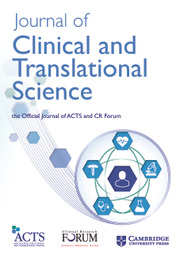No CrossRef data available.
Article contents
583 Using social network analysis to power translational research collaborations
Published online by Cambridge University Press: 11 April 2025
Abstract
Objectives/Goals: Delving into the intricate web of translational research collaborations, this study analyzed the evolving landscape of the Hispanic Alliance of Clinical and Translational Research from 2020 to 2024 using cutting-edge social network analysis (SNA). SNA is a powerful tool for visualizing, understanding, and harnessing the power of networks. Methods/Study Population: We conducted a systematic document review of all the Alliance IDeA-CTR Network Calls for Pilot Projects from 2020 to 2024 including key attributes of the investigators and collaborators (e.g., academic institution, highest degree, collaborator type). Scientific collaboration was defined as two or more researchers working together in a grant proposal for a pilot project application. Study data was recorded and tracked using an Excel spreadsheet. R-Statistical software was used to analyze and map the networks resulting from collaboration interactions comparing the 2020 Call and 2024 Call. Network statistics were performed including nodes, isolates, edges, components, density, diameter, average degree, and the size of the main component. Results/Anticipated Results: Within a vibrant network comprising over 150 investigators from local and national academic institutions, clinicians (49.3%), and basic researchers (25.4%) are predominant. Initial findings showcase a remarkable surge in interdisciplinary collaborations and affiliations over time. Preliminary findings demonstrated that the number of nodes/actors increased from 16 to 75 comparing 2020 to 2024 and the edges/relationships from 12 to 66. Notably, the number of translational research clusters surged from 4 to 18, with mentorship emerging as a critical conduit bridging diverse research clusters; 16 to 78 nodes in comparison from 2020 to 2024. More extensive collaborative clusters occurred across time with over 20 researchers collaborating. A mentor was the main actor connecting these research clusters. Discussion/Significance of Impact: This study unveils the intricacies and power of translational research dynamics, showing a palpable surge in collaboration diversity and depth. By harnessing data-driven insights, our approach catalyzes informed decision-making to amplify collaboration, diversity, and network efficacy, offering invaluable guidance for policy and practice.
Information
- Type
- Team Science
- Information
- Creative Commons
- This is an Open Access article, distributed under the terms of the Creative Commons Attribution-NonCommercial-NoDerivatives licence (https://creativecommons.org/licenses/by-nc-nd/4.0/), which permits non-commercial re-use, distribution, and reproduction in any medium, provided the original work is unaltered and is properly cited. The written permission of Cambridge University Press must be obtained for commercial re-use or in order to create a derivative work.
- Copyright
- © The Author(s), 2025. The Association for Clinical and Translational Science

